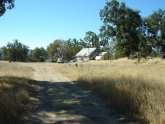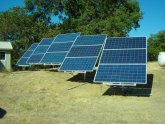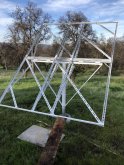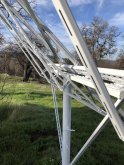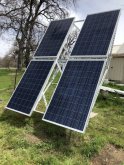You are using an out of date browser. It may not display this or other websites correctly.
You should upgrade or use an alternative browser.
You should upgrade or use an alternative browser.
Anyone still use solar trackers?
- Thread starter spendlove
- Start date
wow 50% is huge. I'm in the Philippines, fairly close to the equator. Currently I just have about 250w of solar panels that I made myself from damaged cells, EVA, and glass. Do you think I"d see that kind of improvement if I came up with a tracking mechanism? Where are you at?Here's a pic of my trackable system, from the back, so you can see the construction. I call it "Hillbilly solar tracking" because I walk out and rotate the panels left and right by hand. It works. I find I can increase my total power by about 50% over the course of the day. ...
HighTechLab
AKA Dexter - CTO of Current Connected, LLC
- Joined
- Sep 23, 2019
- Messages
- 1,699
I had a tracking system setup, welded up on the top of my off grid shipping container. We live on the top of a hill and they really did have a power output improvement, I could vouch for a 50% improvement. They also took 50% more to maintain!! I used cheap tracking systems from Amazon and it seemed that those only lasted about 4 months before they went bad. We would also have to tie down the solar panels if there were any wind events so that added a worry about if it's going to be windy.
I ended up cutting them all up with a plasma cutter about 2 years in when the linear actuator failed for the 2nd or 3rd time and the control box cooked for the 5th time. I was so close to using a plc to automate a tracker of my own, when I finally came across a deal for 24 solar panels for $1200 and ended up making a much larger ground mount array. I set it up so that one array of panels faced east and the other array faced west, and I now have a much higher capacity to make up for the loss of the tracker.
For some reason the neighbors on the hilltop over a mile away were complaining about it as well and we got a letter from the county asking what the heck we were doing. The container counts as personal property so they can't really enforce much on us, but they wanted to make sure that it wasn't an unpermitted structure.
I ended up cutting them all up with a plasma cutter about 2 years in when the linear actuator failed for the 2nd or 3rd time and the control box cooked for the 5th time. I was so close to using a plc to automate a tracker of my own, when I finally came across a deal for 24 solar panels for $1200 and ended up making a much larger ground mount array. I set it up so that one array of panels faced east and the other array faced west, and I now have a much higher capacity to make up for the loss of the tracker.
For some reason the neighbors on the hilltop over a mile away were complaining about it as well and we got a letter from the county asking what the heck we were doing. The container counts as personal property so they can't really enforce much on us, but they wanted to make sure that it wasn't an unpermitted structure.
MichaelK
Solar Wizard
This is why I went with manual positioning. I tell myself, KISS. In the morning, the arrays only need 2-3 minutes of attention to get them angled just right. Avoiding shading is to top priority. What I find though is that by 9am the sun is now far enough south that I don't need to worry about shading, but I still angle the panels maybe twice before noon, and twice after.I ended up cutting them all up with a plasma cutter about 2 years in when the linear actuator failed for the 2nd or 3rd time and the control box cooked for the 5th time. I was so close to using a plc to automate a tracker of my own, when I finally came across a deal for 24 solar panels for $1200 and ended up making a much larger ground mount array. I set it up so that one array of panels faced east and the other array faced west, and I now have a much higher capacity to make up for the loss of the tracker.
The goal here is just keeping the pump running all day long. Around 3:30 or so I need to worry about shading again. By 4:30pm, I have to shut off the wellpump, because I can't maintain 2000+ watts. By 5:00, shading gets bad enough that I start getting more power by facing the panels due south again. Although the pump is no longer running, I can still get 500-1000 watts out of the system to keep the batteries topped off before sunset. I typically see about 18-20kwh of production per day. With regular night-time loads like lights and TV, I'm still at 90% charge the next morning.
I am upgrading with more panels in the next few weeks. These are going to be positioned in a totally different area on the other side of the cabin, and are designed to be facing due west. The goal is to get enough watts to run the wellpump till after 6pm (or an air conditioner). I found some fantastic deals for panels on Craigslist (1kw for 220$), so I'm throwing more watts at the problem, 1000W at a time. What I'm finding now is the the steel to build the panel frames is costing more than the panels!
MisterSandals
Participation Medalist
The goal here is just keeping the pump running all day long.
That is a LOT of pumping. Can you share a little info and a pic if its interesting?I typically see about 18-20kwh of production per day.
MichaelK
Solar Wizard
We're a family with grown kids, trying to develop a self-sufficent, organic homestead up in the Sierra Nevada, at 5000 feet. Right now we're finishing the construction of our cabin's interior. The only modern ammenity we don't have yet is high-speed internet. I'll get to it! Once we're retired, we'll be ready to move there full-time.
We've planted 100+ trees in our orchard that need constant watering throughout the dry California summers. On the weekends when we're there, we need to pump about 5000 gallons to replenish our storage tanks. We can accomplish that solely now via our solar system, which pumps about 300 gallons/hr out of our deepwater well. In fact, the solar system has worked so well that the piston in our stand-by generator rusted stuck. Here's a pic of the driveway up to the cabin.
We've planted 100+ trees in our orchard that need constant watering throughout the dry California summers. On the weekends when we're there, we need to pump about 5000 gallons to replenish our storage tanks. We can accomplish that solely now via our solar system, which pumps about 300 gallons/hr out of our deepwater well. In fact, the solar system has worked so well that the piston in our stand-by generator rusted stuck. Here's a pic of the driveway up to the cabin.
Attachments
erik.calco
Solar Badger
That is the ONLY thing that kept me from buying property out in the country. But, I did see in KY they wired an entire rural county with high speed. So it does exist somewhere.The only modern ammenity we don't have yet is high-speed internet. I'll get to it!
Satellite won't work because it has a delay and I need real-time speed.
Bigbillsd
New Member
- Joined
- Oct 10, 2019
- Messages
- 197
Nice, seeing that is cool. Are each of them single panels or are there many on each pole. Its difficult to tell the scale of them.Here's a pic of my trackable system, from the back, so you can see the construction. I call it "Hillbilly solar tracking" because I walk out and rotate the panels left and right by hand. It works. I find I can increase my total power by about 50% over the course of the day. The frame holding the panels has door hinges welded to a horizontal unistrut welded on top of a 4" schedule 40 steel pipe. The 4"pipe sits on top of a 3.5" pipe sunk in concrete. the horizontal struts at the bottom allow me to make seasonal angle adjustments. My primary goal is running my wellpump, which requires about 2200W, and rotating the arrays allows me to pump from 8:30am to 4:30 pm instead of 10:30 till 2:30. In the early morning and the late afternoon, I fiddle with the panels so they won't shade each other, but after about 9:30 they only need to be moved 2 or three times.
View attachment 9648
MisterSandals
Participation Medalist
Looks like 3 horizontal panels each pole.Are each of them single panels or are there many on each pole
MichaelK
Solar Wizard
The smaller arrays hold three 72-cell panels, 900W per array. The larger array holds four 60-cell panels for a total of 1000W. Using larger steel members and multiple unistruts in parallel, I've drafted a design that could hold six of those. That array is still in the conceptual phase.Nice, seeing that is cool. Are each of them single panels or are there many on each pole. Its difficult to tell the scale of them.
Attachments
Do you have any good links for cheap DIY manual positioning systems? My current situation has me kind of limited on real-estate for placing panels (the house isn't mine ... yet), so it'd be great if I could maximize with positioning. I'm home very often so I can easily walk out every few hours and move something around. I know how to weld (ugilly), thank you youtube, so it's fine if the DIY includes that.This is why I went with manual positioning. I tell myself, KISS. In the morning, the arrays only need 2-3 minutes of attention to get them angled just right. Avoiding shading is to top priority. What I find though is that by 9am the sun is now far enough south that I don't need to worry about shading, but I still angle the panels maybe twice before noon, and twice after.
The goal here is just keeping the pump running all day long. Around 3:30 or so I need to worry about shading again. By 4:30pm, I have to shut off the wellpump, because I can't maintain 2000+ watts. By 5:00, shading gets bad enough that I start getting more power by facing the panels due south again. Although the pump is no longer running, I can still get 500-1000 watts out of the system to keep the batteries topped off before sunset. I typically see about 18-20kwh of production per day. With regular night-time loads like lights and TV, I'm still at 90% charge the next morning.
I am upgrading with more panels in the next few weeks. These are going to be positioned in a totally different area on the other side of the cabin, and are designed to be facing due west. The goal is to get enough watts to run the wellpump till after 6pm (or an air conditioner). I found some fantastic deals for panels on Craigslist (1kw for 220$), so I'm throwing more watts at the problem, 1000W at a time. What I'm finding now is the the steel to build the panel frames is costing more than the panels!
MichaelK
Solar Wizard
The inexpensive trackers I've seen are flimsy jokes in my mind! Yes, my welds are pathetic too; that's why all my pics are from 30 feet away!Do you have any good links for cheap DIY manual positioning systems? My current situation has me kind of limited on real-estate for placing panels (the house isn't mine ... yet), so it'd be great if I could maximize with positioning. I'm home very often so I can easily walk out every few hours and move something around. I know how to weld (ugilly), thank you youtube, so it's fine if the DIY includes that.
Here's what you can do on a temporary basis. Make some trusses out of treated 2X4s and build a 3-dimensional frame that sits on the ground. Nail a few diagonal braces so the frame doesn't fall over. Cut a few short pieces of slotted angle-iron that you screw into the SIDES of the angled 2X4s. You then mount the panels on the frame such that the bolts go through the panel frame and are bolted onto the angle-iron.
You just drag it out to where you want it and orient as needed. For stormy days I'd throw some sand bags or other anchor weights on the base members to keep the array from blowing away. For short-term use this might work long enough till your living situation changes. I have no clue though whether or not that will survive the kinds of storms your area has. What I can tell you though is that my welded arrays have survived storms that have toppled 18" oaks, like what you see in the background of my pictures.
MichaelK
Solar Wizard
OK, I finally have pics of my latest V4.0 design, installed this last weekend, and now producing power. In the first pic you can see the overall shape. It's modular, with a T-shaped lower half that sits on top of a 3.5" pipe sunk in concrete. The top of the "T" is made of two parallel peices of side by side unistrut, welded together. This unistrut pair is welded on top a 4" square peice of 1/4" steel plate welded on top of the 4" center post.
The bottom "T" section is lifted up and placed on top of the concreted post before the "double-H" frame is bolted to it. The double-H frame, also made from unistruts, is bolted onto the top of the "T" and is what holds the panels. If you look at the back side of the double-H frame you can see the 4 trusses I added to increase rigidity. The 2 outer trusses are welded in place. The 2 inner trusses however, are cantilevered to cross over the hinge area, and bolted in place, so they don't inhibit seasonal tilting of the array.
The third pic is the completed array with the panels mounted. Note that I designed this array to hold panels in two different orientations. In the vertical orientation, four 250W panels can be positioned. Alternatively, I could have positioned the panels horizontally, whereby I could have mounted six 250W panels. Because I've standardized on using 120VDC in all my systems, I used the four-panel configuration.
This array is positioned on the west side of my cabin, away from all the other arrays, so I could increase output late in the afternoon after 5pm. Ultimate goal is to be able to run a small air-con late in the afternoon until almost sunset. The modular design let my son and I assemble the whole thing in just an hour or so, but the individual sections might be assemble by one person if no-one's around to hear the whining
The bottom "T" section is lifted up and placed on top of the concreted post before the "double-H" frame is bolted to it. The double-H frame, also made from unistruts, is bolted onto the top of the "T" and is what holds the panels. If you look at the back side of the double-H frame you can see the 4 trusses I added to increase rigidity. The 2 outer trusses are welded in place. The 2 inner trusses however, are cantilevered to cross over the hinge area, and bolted in place, so they don't inhibit seasonal tilting of the array.
The third pic is the completed array with the panels mounted. Note that I designed this array to hold panels in two different orientations. In the vertical orientation, four 250W panels can be positioned. Alternatively, I could have positioned the panels horizontally, whereby I could have mounted six 250W panels. Because I've standardized on using 120VDC in all my systems, I used the four-panel configuration.
This array is positioned on the west side of my cabin, away from all the other arrays, so I could increase output late in the afternoon after 5pm. Ultimate goal is to be able to run a small air-con late in the afternoon until almost sunset. The modular design let my son and I assemble the whole thing in just an hour or so, but the individual sections might be assemble by one person if no-one's around to hear the whining
Attachments
limey44460
New Member
- Joined
- Feb 18, 2020
- Messages
- 32
solar trckers are dirt cheap compared with the cost and effort of mounting more panels.IMHO, It depends on what's wrong with them, how much it'll cost to fix and maintain. Might be good, might be bad.
I'm totally serious, can you send me some links? I had written them off as either too expensive or unreliable.solar trckers are dirt cheap compared with the cost and effort of mounting more panels.
I'd love to do solar tracking if this is a real option. Thanks in advance.
MichaelK
Solar Wizard
For my DIY trackers, I'm finding that I'm spending twice as much money on the steel to make the frames, then I am the panels. I'm still utilizing tracking arrays not so much so because I want maximal production, but maximal production at a certain time of day. If I want to start my wellpump at 7:30am, I MUST have tracking. That being said, since I also make my stationary frames out of the same steel, the cost difference is just a few hundred$.solar trckers are dirt cheap compared with the cost and effort of mounting more panels.
Just a short few years ago, I know a guy on Craigslist that was selling 10' unistruts for 5$ each. Just bought what I needed at the time. Now, as I get a little array crazy, I wish I had bought a truckload. But I didn't, so now I pay retail at Home Depot. If I still had access to that steel, you'd see some really fancy designs.
Hey, have you ever tried mirrors? I've been contemplating making a "mirror sun tracker" since they are much lighter (though it may be manual at first). Have the mirrors follow the sun and redirect extra light to the panels (even if panels are already tracking)?For my DIY trackers, I'm finding that I'm spending twice as much money on the steel to make the frames, then I am the panels. I'm still utilizing tracking arrays not so much so because I want maximal production, but maximal production at a certain time of day. If I want to start my wellpump at 7:30am, I MUST have tracking. That being said, since I also make my stationary frames out of the same steel, the cost difference is just a few hundred$.
Just a short few years ago, I know a guy on Craigslist that was selling 10' unistruts for 5$ each. Just bought what I needed at the time. Now, as I get a little array crazy, I wish I had bought a truckload. But I didn't, so now I pay retail at Home Depot. If I still had access to that steel, you'd see some really fancy designs.
Most panels will produce more energy this way, though years back I read somewhere that it can also shorten the panel life if done to extremes. I'm contemplating just doing it on cloudy/rainy days or something (when panels are well bellow 100% productivity). Still in the brainstorming mode.
MichaelK
Solar Wizard
Well, give it a try and get back to us about the results.Hey, have you ever tried mirrors? I've been contemplating making a "mirror sun tracker"
it'll be a couple of months. Waiting for lockdown to end here then I'm upgrading to a real off-grid system. I did experiment with mirrors on my home-made panels, and they absolutely boosted power output. I was able to get well over cell rated capacity; I don't remember how much 20% feels right.Well, give it a try and get back to us about the results.
ghostwriter66
"Here - Hold my Beer"
The smaller arrays hold three 72-cell panels, 900W per array. The larger array holds four 60-cell panels for a total of 1000W. Using larger steel members and multiple unistruts in parallel, I've drafted a design that could hold six of those. That array is still in the conceptual phase.
I fricking LOVE PVC mounting systems ... they won't let me touch a welder anymore BUT will let me still use a Mitre saw so I make these PVC mounts all the time ... My trick is that I pour cement into the GROUND tubes when i am done and their not going anywhere after that .....
Similar threads
- Replies
- 33
- Views
- 2K
- Replies
- 28
- Views
- 2K
- Replies
- 14
- Views
- 605
- Replies
- 0
- Views
- 241



